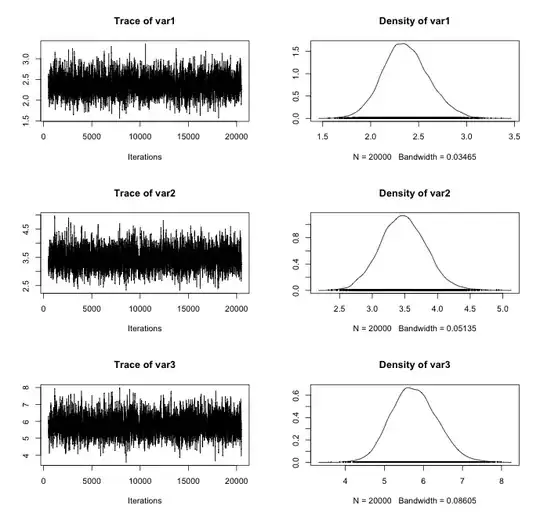I want to obtain posterior distribution for parameters of a Dirichlet distribution $x = (p_1,p_2,p_3) \sim Dir(p_1,p_2,p_3; a_1,a_2,a_3)$ with uniform $P(a_1,a_2,a_3)$ and observed data $X=\{x_1,x_2,...,x_n\}$. What I have is:
$$Pr(a_1,a_2,a_3 | X) \propto P(X|a_1,a_2,a_3)= \Pi_{i}^nP(x_i|a_1,a_2,a_3)$$ $$=\Bigg[\frac{\Gamma(a_1 + a_2 + a_3)}{\Gamma(a_1)\Gamma(a_2)\Gamma(a_3)}\Bigg]^n (\Pi_i^nx_{i1})^{a_1}(\Pi_i^nx_{i2})^{a_2}(\Pi_i^nx_{i3})^{a_3} (*)$$ How can we sample $(a_1,a_2,a_3)$ from this exotic distribution? Is a more intuitive distribution for $$Pr(a_1,a_2,a_3 | X) \propto \Bigg[\frac{\Gamma(a_1 + a_2 + a_3)}{\Gamma(a_1)\Gamma(a_2)\Gamma(a_3)}\Bigg](\frac{\sum_i x_{i1}}{\sum_i x_{i1}+\sum_i x_{i2}+\sum_i x_{i3}})^{a_1}(\frac{\sum_i x_{i2}}{\sum_i x_{i1}+\sum_i x_{i2}+\sum_i x_{i3}})^{a_2}(\frac{\sum_i x_{i3}}{\sum_i x_{i1}+\sum_i x_{i2}+\sum_i x_{i3}})^{a_3}$$ ? Is there a mathematical way to derive this? Empirically, it seems to give a good posterior for the distribution of $(a_1,a_2,a_3)$, but I cannot see how to derive it. Any help is appreciated.
Note that the data $X$ is generated by the Dirichlet distribution, there is no multinomial distribution here. $X$ is a collection of tupples of ratios (the elements of each data points in $X$ is less than 1).
